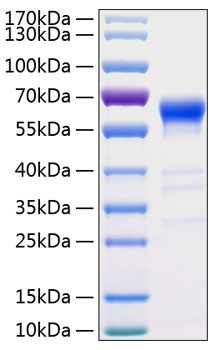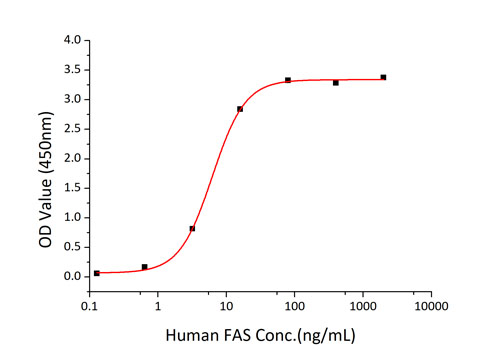Description
Recombinant Human TNFRSF6/FAS/CD95 Protein
The Recombinant Human TNFRSF6/FAS/CD95 Protein is a biologically active recombinant protein that plays a significant role in various cellular processes and signaling pathways in human biology. This protein is widely employed in immunological research, cell biology studies, protein-protein interaction analyses, and therapeutic development, providing researchers with a reliable tool for investigating TNFRSF6/FAS/CD95 function and its implications in health and disease.
This product (SKU: RPCB0310) is produced using HEK293 cells and features a C-hFc&His tag for convenient detection and purification. The protein exhibits a calculated molecular weight of 43.43 kDa with an observed molecular weight of 55-70 kDa under denaturing conditions, achieving ≥ 90 % as determined by SDS-PAGE.. Functional bioactivity has been validated through rigorous quality control assays, confirming its suitability for demanding research applications.
Key Features
| High Purity by Affinity Chromatography | |
| Mammalian & Bacterial Expression Systems | |
| High lot-to-lot consistency via strict QC |
| Product Name: | Recombinant Human TNFRSF6/FAS/CD95 Protein |
| SKU: | RPCB0310 |
| Size: | 10 μg , 50 μg , 100 μg |
| Reactivity: | Human |
| Synonyms: | ALPS1A, APO-1, APT1, CD95, FAS1, FASTM, TNFRSF6, FAS, ALPS1A, APO-1, APT1, CD95, FAS1, FASTM, TNFRSF6, Fas cell surface death receptor |
| Tag: | C-hFc&His |
| Expression Host: | HEK293 cells |
| Calculated MW: | 43.43 kDa |
| Observed MW: | 55-70 kDa |
| Gene ID: | 355 |
| Protein Description: | High quality, high purity and low endotoxin recombinant Recombinant Human TNFRSF6/FAS/CD95 Protein (RPCB0310), tested reactivity in HEK293 cells and has been validated in SDS-PAGE.100% guaranteed. |
| Endotoxin: | < 0.1 EU/μg of the protein by LAL method. |
| Purity: | ≥ 90 % as determined by SDS-PAGE. |
| Formulation: | Lyophilized from a 0.22 μm filtered solution of PBS, pH 7.4.Contact us for customized product form or formulation. |
| Bio-Activity: |
|
| Reconstitution: | Centrifuge the vial before opening. Reconstitute to a concentration of 0.1-0.5 mg/mL in sterile distilled water. Avoid vortex or vigorously pipetting the protein. For long term storage, it is recommended to add a carrier protein or stablizer (e.g. 0.1% BSA, 5% HSA, 10% FBS or 5% Trehalose), and aliquot the reconstituted protein solution to minimize free-thaw cycles. |
| Storage: | Store at -20℃.Store the lyophilized protein at -20℃ to -80 ℃ up to 1 year from the date of receipt. After reconstitution, the protein solution is stable at -20℃ for 3 months, at 2-8℃ for up to 1 week. |
The protein is a member of the TNF-receptor superfamily. This receptor contains a death domain. It has been shown to play a central role in the physiological regulation of programmed cell death, and has been implicated in the pathogenesis of various malignancies and diseases of the immune system. The interaction of this receptor with its ligand allows the formation of a death-inducing signaling complex that includes Fas-associated death domain protein (FADD), caspase 8, and caspase 10. The autoproteolytic processing of the caspases in the complex triggers a downstream caspase cascade, and leads to apoptosis. This receptor has been also shown to activate NF-kappaB, MAPK3/ERK1, and MAPK8/JNK, and is found to be involved in transducing the proliferating signals in normal diploid fibroblast and T cells. The isoforms lacking the transmembrane domain may negatively regulate the apoptosis mediated by the full length isoform.








